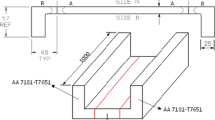Abstract
Roll bonding is extensively used in various industries for obtaining engineering components comprising several metallic layers. The load-bearing ability of such components strongly depends on the interface bonding strength between these layers. Nevertheless, the relation between the thermo-mechanical fields that develop at the interface during rolling and the resulting bonding strength is still not clearly defined. The current study presents a coupled thermo-mechanical computational investigation of a hot roll bonding process of aluminum plates validated by experiments. A novel experimental rolling configuration proposed in this study enables evaluating the interface strength by subsequent three-point bending tests. The rolling models were used for analyzing the time-dependent thermo-mechanical fields that develop at the interface for different reduction ratios. It is demonstrated that a 2D FE representation is not sufficient to accurately describe the interface conditions and a 3D analysis must be used. The computed fields in the deformation zone examined the bonding strength using a previously published bonding strength criterion for solid state bonding in bridge die extrusion.






Similar content being viewed by others
References
P. Cavaliere, Cold Spray Coatings: Recent Trends and Future Perspectives (New York: Springer, 2018).
C. Ranganayakulu and K. Seetharamu, Compact Heat Exchangers: Analysis, Design and Optimization using FEM and CFD Approach (New York: Wiley, 2018).
A. Lyons, Materials for Architects and Builders (New York: Taylor & Francis, 2010).
J. Davis, ASM Specialty Handbook: Aluminium and Aluminium Alloys (Ohio: ASM International, 1993).
E. Priel, Z. Ungarish, and N.U. Nissim, J. Mater. Process. Technol. 236, 103 (2016).
G. Hirt and S. Senge, Proc. Eng. 81, 18 (2014).
N. Kazakov, Diffusion Bonding of Materials (New York: Pergamon Press, 1985).
L. Li, K. Nagai, and F. Yin, Sci. Technol. Adv. Mater. 9, 023001 (2008).
G. Chen, J. Li, H. Yu, L.H. Su, G.M. Xu, J. Pan, T. You, G. Zhang, K.M. Sun, and L. He, Mater. Des. 112, 263 (2016).
I. Topic, H. W. Hoppe, D. Staud, M. Merklein, M. Geiger, and M. Goken, Adv. Eng. Mater. 10, 1101 (2008)
E. Kim, J. Cho, H. Kim, and S. Choi, Mater. Sci. Eng., A 530, 244 (2011).
T. Inoue, A. Yanagida, and J. Yanagimoto, Mater. Lett. 106, 37 (2013).
R. Kebriaei, I. Vladimirov, and S. Reese, J. Mater. Process. Technol. 214, 2146 (2014).
T. Altan, G. Ngaile, and G. Shen, Cold and Hot Forging: Fundamentals and Applications (Ohio: ASM International, 2005).
O.C. Zienkiewicz and R.L. Taylor, The Finite Element Method: Solid Mechanics, Vol. 2 (London: Butterworth Heinmann, 2000).
COMSOL Multiphysics (R) V. 5.2 www.comsol.com. COMSOL AB, Stockholm, Sweden
H. Mehrer, Diffusion in Solids: Fundamentals, Methods, Materials, Diffusion Controlled Processes (New York: Springer, 2007).
M. Plata and J. Piwnik, in Proceedings of the 7th International Aluminium Extrusion Technology Seminar ET I, p. 205 (2000)
E. Cerretti, L. Mazzoni, and C. Giardini, Int. J. Metal Form. 2, 101 (2009).
S. Bingol and A. Bozaci, Materials 8, 4389 (2015).
J. Kim, D. Jo, and B. Kim, Proc. Eng. 207, 586 (2017)
Acknowledgements
The authors would like to thank M. Nahmany and Y. Benishti for assisting with specimen preparation and Y. Hadad, Y. Tzriker, and D. Hai David for assisting with the rolling experiments.
Author information
Authors and Affiliations
Corresponding author
Appendix: Thermal Analysis of Temperature Field Prior to Rolling
Appendix: Thermal Analysis of Temperature Field Prior to Rolling
As stated in the text, the composite specimen is heated to T = 485°C in the furnace; however, during the transfer to the rolling mill, heat is lost due to convection to the surrounding air and by conduction to the feeding tray. Although this transfer process is short (less than 10 s), it cannot be neglected since the temperature of the specimen changes significantly. To obtain an estimation of this temperature drop, a separate thermal FE analysis was conducted. The computational mesh was similar to the one described in the text, but the elements contained only temperature degrees of freedom. The computation comprised two stages:
-
1.
Transport of the specimen from the furnace to the rolling mill tray through the air, which considered heat loss by convection (the limiting value of natural convection was used [h = 10 (W/m°C)].
-
2.
Heat loss to the feeding tray by conduction, and by convection to the air from all other surfaces, before the specimen passes through the rolling gap.
The computed thermal field distribution at each stage is shown in Fig. 7.
As demonstrated in Fig. 7, the average temperature at the end of the preparation stage is about T = 380°C. This value was validated by a direct temperature measurement on the plate surface and was subsequently used as an initial condition for all rolling computations.
Rights and permissions
About this article
Cite this article
Mittelman, B., Guttmann, G.M. & Priel, E. Computational Analysis of Thermo-Mechanical Fields in Hot Roll Bonding of Aluminum Validated by Experiments. JOM 71, 718–728 (2019). https://doi.org/10.1007/s11837-018-3205-5
Received:
Accepted:
Published:
Issue Date:
DOI: https://doi.org/10.1007/s11837-018-3205-5





